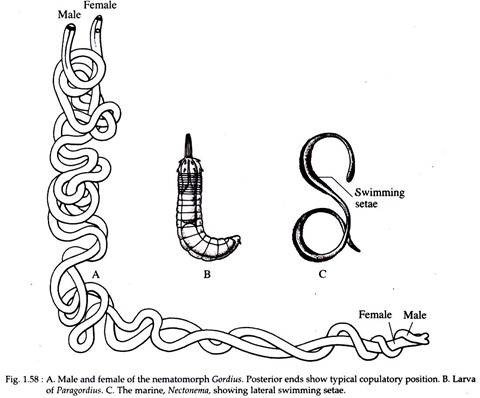
Nematomorphs, often known as horsehair worms, belong to a group of parasitic worms that can be quite captivating to study in their natural environments. These worms undergo amazing transformations, and seeing one in the wild can truly be an eye-opening experience. So, how do you identify a nematomorph in its natural habitat? Grab your binoculars and let’s dive into this fascinating topic.
What Are Nematomorphs?
To kick things off, let’s talk about what nematomorphs actually are. These slender, elongated worms can grow anywhere from a few inches to several feet long, depending on the species. They’re typically smooth and shiny, which adds to their allure. What’s super interesting is that nematomorphs start their lives as parasites in the bodies of insects, often living in hosts like grasshoppers and crickets.
When it’s time for them to mature, they manipulate their host behavior, driving them to water sources where the worms can escape and continue their life cycle. Imagine a tiny puppet master pulling the strings of its puppet, making it jump into water just so it can break free! This bizarre lifestyle is part of what makes identifying nematomorphs so intriguing, as you might find them swimming in freshwater habitats, such as ponds and streams.
Where to Look for Nematomorphs
Now that you know what they are, where can you actually spot these slippery critters? You’ll want to focus on freshwater environments—think ponds, streams, and marshes. These habitats provide the ideal conditions for nematomorphs, with plenty of potential insect hosts around.
When you’re out exploring, look for areas with vegetation near water. The edges of ponds, for example, are prime spots. You might also find them in shallow regions where insects are plentiful. Remember, nematomorphs love to come out when it’s warmer, especially in the spring and summer months. So if you’re gearing up for a nature walk during those seasons, keep your eyes peeled!
How to Identify a Nematomorph
When you encounter a possible nematomorph, it’s all about observing the details. First things first, look at the shape—they’re long, thin, and often slightly curved. They can range from transparent to a darker brown or green hue, depending on the species and their environment.
Next, pay attention to their movement. Unlike a typical worm, nematomorphs can be quite lively, often swimming through the water with an almost choreographed grace. Their movements can be erratic, which is particularly noticeable when they’re attempting to escape predators or when they’re ready to reproduce. Watching how they move can help you distinguish them from other similar-looking creatures.
Behavioral Traits to Note
If you’re still unsure, let’s dive into some behaviors that stand out. When a nematomorph is ready to leave its insect host, it often causes the insect to seek out water. Once it jumps in, you might see the nematomorph wriggling out. This dramatic exit is a sight to behold!
Additionally, nematomorphs are also notable for their feeding habits. As adults, they don’t eat much and typically live off energy stores from their time as parasites. If you spot one, you might find it resting on plants or floating near the surface, seemingly indifferent to its surroundings.
Common Mistakes: Confusing Nematomorphs with Other Creatures
It’s easy to mix up nematomorphs with other aquatic creatures like leeches or earthworms. Here’s the thing: while leeches are often darker and have a more segmented body, nematomorphs are smooth and slender. Earthworms, on the other hand, are usually thicker and found in soil rather than water.
To help you differentiate, consider making a quick comparison chart:
| Creature | Body Shape | Habitat |
| Nematomorph | Long, slender, smooth | Freshwater environments |
| Leech | Flat, segmented | Freshwater, moist soil |
| Earthworm | Thicker, segmented | Soil |
This comparison can help clarify the key distinctions and assist you during your nature explorations.
The Role of Nematomorphs in Ecosystems
So why bother learning about nematomorphs? Well, they play a significant role in their ecosystems. As parasites, they help control insect populations, which can be beneficial for the environment. They’re also a food source for various animals, including birds and fish.
Furthermore, their unique life cycle offers insights into complex ecological interactions. Observing nematomorphs can deepen your appreciation for biodiversity and the interconnectedness of life in a habitat.
Conservation and Habitat Protection
As with many species, conservation efforts are essential for the survival of nematomorphs. Their habitats face threats from pollution, habitat destruction, and climate change. Protecting freshwater environments is key to ensuring these fascinating creatures continue to thrive.
So, if you’re exploring an area with potential nematomorph sightings, consider the impact you have. Clean up after yourself, avoid using harmful chemicals, and advocate for local conservation efforts. Every little bit helps!
In conclusion, identifying a nematomorph in its natural habitat can be an exciting and educational experience. By knowing what to look for and understanding their behavior, you’ll be better equipped to spot these remarkable creatures. Next time you’re near a pond or stream, take a moment to observe the fascinating life unfolding beneath the water’s surface. Who knows what you might discover? Happy exploring!
